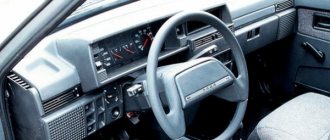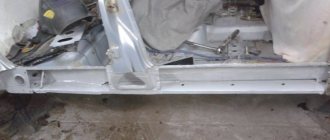What can and should be done
Types of modernization work:
- Make noise insulation of the interior;
- Change seats;
- Re-upholstery;
- Install a “non-native” dashboard;
- Remodel or replace appliances;
- Cover with film (carbon, wood, aluminum);
- Make neon interior lighting;
- Install electric windows;
- Replace the rear side windows with opening ones;
- Install air conditioning;
- Cover the floor with aluminum;
- Carry out auto sound preparation;
You can read more about much of this list in the Interior Tuning section.
To imagine the entire scope of work on internal tuning and visualize the result of such changes, we recommend looking at the corresponding photos and videos at the bottom of the page.
How Niva has changed over 43 years
This year Niva turned 43 years old. Not a single AvtoVAZ car lasted on the assembly line for so long. What has changed in him during all this time? What updates and upgrades have taken place? All this is discussed in today’s material from Droma.
VAZ-2121 "Niva" - or now Lada 4x4 - is without a doubt the longest-lasting and most successful AvtoVAZ car. Over more than 40 years of production, 2.2 million copies of this legendary SUV with a timeless design were produced, of which almost half a million were exported to various countries. Some, by the way, consider the Niva to be the first crossover to appear in the world. The Lada 4×4 has a huge number of achievements: participation in the Paris-Dakar rally (1978–1988), climbing mountain peaks (Fujiyama - 3776 m in 1998, Everest - 5200 m in 1999, Himalayas - 5726 m in 1999), conquest of the North Pole (1998), work in Antarctica and various special services, filming in numerous Soviet and foreign films and the largest circulation among AvtoVAZ export products...
The Russian Lada 4×4 is the most capable SUV in the world, which can be bought for less than €10,000. This car has repeatedly confirmed its extraordinary cross-country ability in Droma tests
It is clear that no car can be produced for more than 40 years without any changes. Time passes, new technologies appear, new requirements for safety and comfort arise, and the consumer portrait of a potential buyer changes. To be honest, the Niva has basically remained almost the same - it is still the same ultra-budget, small-class off-road passenger car with a monocoque body, spring suspension and an almost unchanged appearance, permanent all-wheel drive and a locking center differential, with a "lowering" gear. and free cross-axle differentials. And yet, all these many years, constant work was carried out to modernize the model. Today we will talk about the main milestones in this history of changes, the appearance of various modifications. But first, let’s remember what the very first production Niva was like, which rolled off the VAZ assembly line in Tolyatti on April 5, 1977.
1977: the first Niva VAZ-2121
For the late 1970s, the design of the VAZ-2121 was very progressive. Especially in terms of the monocoque body and all-wheel drive with a center differential with the ability to lock it. Toyota released something similar - although in a much more modern interpretation - only in 1994, when it began production of the RAV4 model.
Under the hoods of the first Nivas, a 1.6-liter 4-cylinder carburetor engine with a timing chain drive was installed, based on the engine from the VAZ-2106 and developing 80 hp. and 116 Nm. In addition, the 4-speed gearbox and rear axle gearbox were also borrowed from the “six”. The interior also resembled a “six” - metal panels on the top, a two-spoke steering wheel with a thin rim, the same dashboard, classic round “Zhiguli” air ducts at the top of the front panel, front seats... The most obvious and obvious difference was the presence of two additional levers next to the selector “ mechanics" - one included the lowering row, and the second blocked the "center". This scheme is still used on Lada 4x4.
In these “sections” and the photo below, you can examine in detail the design of the VAZ-2121: a monocoque three-door body, a spring suspension (in the front, independent on wishbones, in the rear - an axle with a Panhard rod), a longitudinally mounted engine, a manual gearbox with a transfer case and the possibility of locking "center", located under the hood "spare"
The Niva immediately became very popular - after all, it was the only Soviet all-wheel drive passenger car with a similar level of comfort and cross-country ability. Some components and assemblies were considered quite reliable (for example, the engine or the “indestructible” 4-speed manual transmission), but at the same time, like almost any new car, the VAZ-2121 in the first years of production had quite significant problems. Below we provide a list of the most common ones. We had to wait decades for solutions to many of these shortcomings.
The most common problems of the first Nivas
Standard tires VLI-5
Poorly suited for driving on asphalt: high noise level, low grip, rapid wear.
Body corrosion
The rapid appearance of rust spots on the tailgate (with a very high loading height), sills, joints of the pillars and roof, and the floor in the area where the transfer case is mounted.
Poor sealing
Worthless seals, water in the cabin even after heavy rain.
Radiator fan mechanically driven by crankshaft
Insufficient air flow at idle, overheating.
Bad "stove"
Noise in the fan, leaking heater tap (antifreeze in the cabin), improperly organized airflow, cold in winter.
Cardan crosspieces
They require constant maintenance, fail quickly, and are difficult to replace.
Clutch
You can “burn out” the clutch due to a weak engine in a couple of off-road trips.
Transfer case
Constant hum, vibration, souring of the control mechanism.
Front-wheel drive (CV joints)
Wear of anthers, possibility of rupture under severe off-road loads or presence of blocking at the front.
Front wheel wheel bearings
Requires constant adjustment and lubrication.
Rear drum brakes
The need to constantly adjust the gap.
1994: VAZ-21213 “Taiga”
For 15 long years, the VAZ-2121 was produced without any major upgrades, the owners already knew about all the “jambs”, knew how to fix them to the best of their ability, and placed a cap with earflaps on the central tunnel to reduce the amount of noise and hum from the transfer case. The first transitional modifications appeared in 1993, and fully modified Nivas rolled off the assembly line in 1994. At first, they even wanted to give the VAZ-21213 version its own name - “Taiga”, but it didn’t catch on. Nevertheless, the number of changes made was significant.
Firstly, Niva has changed in appearance. The rear door with a different handle was extended to the bumper, which made loading and unloading much easier, and new lights appeared on the sides. Secondly, they began to install a VAZ-21213 engine under the hood with a volume increased (due to the longer piston stroke from the VAZ-21083) to 1.7 liters and a Solex carburetor. It also changed the profile of the camshaft cams, which made it possible to expand the intake and exhaust phases, improve cylinder filling and increase torque to 127 Nm. But the mechanical fan drive from the crankshaft remained. But on the engine with single injection - 21214 - electric fans were already used. True, this engine was initially used only on export versions, and the Russians had to wait for the injector for almost ten more years. Thirdly, the Niva has been equipped with a 5-speed manual transmission ever since. But the reliability of this gearbox turned out to be worse than that of the old one: converted from a “four-speed”, it suffered from oil starvation of the fifth gear gear block, and was also not of such high quality materials. Fourthly, after 1994, the output shaft of the gearbox and the input shaft of the transfer case began to be connected by a drive shaft, in which the cross was replaced with a CV joint, which made it possible to slightly reduce noise and vibration.
This is one of Drome's most popular videos, already gaining almost 2 million views! In it, the Lada 4x4 is compared with the Renault Duster in the same off-road conditions:
In the same year, the most significant (up to 2019) change in the interior occurred. New seats were installed, the “tidy” from the “eight-nine” settled in front of my eyes, a different, more “meaty” steering wheel and other, very flimsy air ducts appeared.
Niva engines can run on almost any fuel!
Over the course of its long life, Nivs have featured a variety of power plants under their hoods. In addition to the “classic” 4-cylinder gasoline units, the Peugeot XUD-9L diesel engine with a volume of 1.9 liters and a power of 65 hp was installed on export cars (the VAZ-21125 was produced at the Moscow region enterprise LfaExport JSC), and in 2001 at the Moscow International At the auto show, they even demonstrated a prototype of “Antel” using... a hydrogen installation!
1995: VAZ-2123 - long-wheelbase 5-door modification
Niva had three-door extended versions until 1995 (for example, the VAZ-212180 Fora, “stretched” by 300 mm or the VAZ-2129 Kedr), but it was this year that official sales of the five-door modification of the VAZ-2131 began with wheelbase increased by as much as 500 mm. This version is still in service - an excellent option for those who want to win in convenience, spaciousness and comfort at the expense of a slight deterioration in off-road performance.
By the way, at first the five-door cars were equipped with a 1.8-liter power unit 2130 (82 hp, 139 Nm), which was famous for the factory defects of the cylinder block in early versions, the constant need to adjust the valves and instability at idle speed .
In this video, the previous generation Suzuki Jimny competes with the long-wheelbase 5-door Lada 4×4:
2001: Niva becomes Lada 4x4
In 2001, AvtoVAZ sold the Niva brand to the joint venture GM-Avtovaz, which mastered the production of the Chevrolet Niva car. In return, the Lada 4×4 received a number of modifications mastered at Chevy. A Valeo clutch was installed, and the problem with low brake performance was solved by installing a new 9-inch vacuum booster and a larger diameter master cylinder (22.22 mm versus 20.64 mm). There are non-adjustable wheel bearings, new steering knuckles in the front suspension with a reduced rolling arm, as well as more powerful silent blocks of the lower arms, optimized for the length of the compression and rebound buffer. The dimensions of the shock absorbers were increased, and the lower rear mounts were changed, as was the position of the longitudinal rods. The front gearbox was moved and attached to the front suspension beam.
2002: engine 21214 with central fuel injection
In 2002, AvtoVAZ finally launched a car with an injection 1.7-liter engine 21214-20 (81 hp, 128 Nm) with mono-injection and a single-row timing chain (previously there was a double-row), meeting Euro-2 emission standards . About 75% of the parts of this engine were borrowed from the VAZ-2131, but at the same time it could not do without a number of new devices and sensors: a Bosch or “January” controller, a crankshaft with a long (40 mm) crank radius, a cylinder head with holes for valve timing sensor and receiver studs, hydraulic valve compensators instead of adjusting bolts and PCV and idle speed sensors.
2009–2011: changed appearance, power steering and engine 21214M
The next update of Lada 4x4 began in 2009. Externally, the Niva has not changed much - a new radiator grille, daytime running lights and turn signals have appeared, as well as mirrors of a slightly different shape. Inside, the seat upholstery has changed, the electronic instrument panel is now from the VAZ-2115, and the rear seat began to fold in two stages - first the cushion, and then the backrest. But there were plenty of technical innovations.
They began to install a modernized VAZ-21214M unit under the hood, which was equipped with distributed injection and complied with Euro-3 environmental standards (and then to this day - Euro-5). To eliminate coolant leaks, new gaskets with an elastic silicone bead were introduced, which retain their properties throughout the entire service life of the vehicle and do not require tightening. The pump used a new imported seal. Some modifications began to be equipped with ABS, the diameter of the Valeo clutch increased from 200 to 215 mm, and since 2007, the Lada 4×4 began to be equipped with power steering.
2014–2019: Lada 4×4 Urban, air conditioning and further modernization
In 2014, the Lada 4×4 began production of the “city” version Urban - plastic bumpers, a new radiator grille, black previously chromed parts, athermal glass, metallic colors and R16 alloy wheels. The interior features a new “chubby” steering wheel with a smaller diameter, improved sound insulation, a VDO instrument panel, extended windshield wipers, cup holders on the center tunnel, heated seats, power windows and mirror controls, and most importantly, air conditioning!
But the list of internal changes for the Lada 4×4 turned out to be quite impressive. The crosspieces on the cardan shafts of the axle drives have finally given way to CV joints, which has reduced noise and vibration. Finally, the body began to be painted using cataphoretic and polyester primers, which improved corrosion resistance. Also over the years, a number of smaller innovations were introduced: ABS and Isofix fastenings appeared on the five-door version, the rear seat belt fastenings were moved, new rear door upholstery was used, double-sided windshield washers and a metal cord sheath for the hood opening drive cable.
Comparison of the penultimate reincarnation of the 2022 Lada 4×4 with the new Suzuki Jimny off-road:
2019: latest update so far
We still believe that the interior of the very first Niva looked most organic and charismatic. All its updates over the past 40 years resembled some kind of semi-finished product, although Lada acquired things necessary for comfort and safety, such as an airbag (only a side one! - for the correct operation of ERA-GLONASS) and air conditioning. It seems that AvtoVAZ also understood the need for radical changes, and finally we have seen them: since last year, all Nivas have been sold with a completely new interior and slightly modified appearance.
All versions (not only Urban) are now equipped with plastic bumpers, and fog lights are also implanted in the front one. The engine now sits on new mounts. But the main differences are in the interior. The most noticeable change is the completely new front panel. The “tidy” is now similar to those of Vesta or XRAY - with orange scales, radial digitization and large arrows. But the most important thing is that an on-board computer with a fuel consumption sensor has finally appeared. Although this is unlikely to greatly console the future owner, because the Niva traditionally cannot boast of efficiency. In the center is a completely new climate control unit with three classic “knobs”—always jamming sliders are a thing of the past! Above it are a row of backlit buttons (turning on the rear wiper and heated glass, air conditioning and recirculation) and other, much neater, air ducts. Below there are a pair of 12-volt outlets. The light control unit is also new, as are the fog light switches. The front seats have changed shape, padding, as well as the sliding mechanism. Massive headrests appeared in the back row, retracting almost flush. New seals were installed in the doorways, and the doors themselves acquired new limiters. The ceiling is now covered with a pile covering, there is a modernized lock at the tailgate, and in the luggage compartment itself there is another 12 V socket. Among the little things - a new lampshade and a button for the ERA-GLONASS system. It cannot be said that with such an interior, the Niva has become a modern car, but still, in both its appearance and functionality, it is the best in all these 43 years.
They say that in 2023 AvtoVAZ plans to begin production of a completely new Lada 4×4. True, this date is constantly being postponed, and no one has 100 percent confidence in the appearance of the new Niva in a couple of years.
And it will be a completely different story using Renault units. Thus, for some time there will be as many as three Nivas left on the market - the old Lada 4×4, the Chevrolet Niva and the new Lada 4×4. It’s a pity, of course, but the “old lady” will soon have to retire one way or another. However, who knows, maybe she will also celebrate her 50th birthday on the assembly line?
Technical characteristics of Lada 4×4
| engine's type | Gasoline L4 |
| Working volume, cubic meters cm | 1690 |
| Max. power, hp at rpm | 83/5000 |
| Max. torque, Nm at rpm | 129/4000 |
| type of drive | Constant full |
| Transmission | 5-speed manual transmission |
| Front suspension | Independent wishbone |
| Rear suspension | Dependent spring |
| Brakes | Disc front and drum rear |
| Dimensions (L/W/H), mm | 3640x1680x1640 |
| Wheelbase, mm | 2200 |
| Curb weight, kg | 1285 |
| Max. speed, km/h | 142 |
| Acceleration 0–100 km/h, sec. | 17,0 |
| Fuel consumption (combined), l/100 km | 9,9 |
| CO2 emissions, g/km, eq. Class | N.D./Euro-5 |
| Ground clearance, mm | 200 |
| Luggage compartment volume, l | 265/585 |
| Fuel tank volume, l | 42 |
| Tire size | 185/75 R16 |
| price, rub. | from 566,900 to 685,900 |
Photobonus
Interior improvements
Despite a wide range of modifications, the Niva's interior requires improvement. When tuning the Niva's interior you need to:
- produce high-quality sound insulation using modern technologies and materials;
- secure the torpedo better, eliminating squeaking when moving;
- improve the interior trim, it is advisable to get rid of the original plastic, which tends to crack;
- A good advantage for the driver will be an armrest, a comfortable steering wheel, and pedal pads.
It all depends on the wishes of the owner. You can improve the heating system and install seat heaters.
Another example of cool tuning of a VAZ 2121 on your own
This car is distinguished by its simplicity of design, easy accessibility to all components and mechanisms, as well as its increased reliability.
If you wish, you can do the tuning of the Niva yourself. To do this you will need:
- have your own garage for work;
- purchase the necessary tools, become familiar with the production process that should be performed;
- consult with specialists; advice from a highly qualified specialist can protect you from possible troubles.
By completing modifications to a car on their own, a person can verify the quality of the work performed, receive great pleasure from the achieved result, and save his money.
If you have insufficient experience, you can involve a master in performing important operations, and become his assistant yourself.
In this case, high-quality work will be done at minimal cost to the family budget.
And also interesting: Niva speed freezes - Help for beginners - Automotive Portal
Modern tuning of Niva 21213
Not so often, but still among Niv owners there are those who do not ignore such “noticeable parts of the interior” - such as the instrument panel, dashboard and the instruments themselves. Which, in turn, can either be slightly modified (for example, changing the color of the scales or the backlight of standard sensors), or completely replaced with others, both from domestic cars and parts from foreign cars.
How to make a dashboard with your own hands?
The process of making a homemade dashboard from plywood is literally “on the knee”.
This instrument panel can be purchased from sellers of tuning parts and accessories. It seems that the choice of alternative plastic dashboards for the VAZ-21214 in online and online stores is relatively large. And if you search, you can find some pretty decent panels.
Often, fans of tuning a domestic SUV decide to completely replace the dashboard or instrument panel with appropriately sized panels from foreign cars. And more often than not, such a replacement is completely justified. Since, in addition to a clear improvement in the visual perception of the interior, comfort and ergonomics are significantly improved.
The first thing you should do in your car so that daily trips in it within the city (and not only) do not lead you into a sad state of a squeezed lemon is to carry out comprehensive sound insulation of the interior.
Before disassembling the entire interior, find the front seats from a foreign car. Seats from Japanese cars have proven themselves well in domestic SUVs. The fact that you need to find rather rare seats from a coupe car should not confuse you.
Any front seats from a foreign car can be easily converted into folding angle grinders with a slight movement - you just need to cut off the stop that limits the forward movement of the backrest.
For safety, we strongly recommend that you do not weld new seats into the body of the Niva, but redesign the slide of the seat itself in order to integrate the lower rails from the original ones. Then the new comfortable chairs will become standard installation locations.
For high-quality sound insulation, you will also need to remove the front panel. Here you will find another key point included in high-quality tuning for Niva 21213 - the dashboard. It can be replaced with a more modern version. A radical solution to changing the appearance of the interior would be to completely replace the front panel with another one.
There is a “comfort” version of the front panel on sale. Its advantages are that there is no need to redo the fasteners, adjust them to size, etc. It has space for both an on-board computer and a tape recorder. The new dashboard and steering wheel will create the complete feeling that you are driving another car. Moreover, every car enthusiast can do such tuning of Niva 21213 with his own hands (photo above).
Deutsche Lada Niva Cabrio
German masters were interested in changing the Soviet Niva. So in 1983, based on this SUV, Deutsche Lada Automobil GmbH, which was the official importer of these cars, introduced a convertible, which completely lacked side pillars and roof strength elements. But a tubular frame appeared, with which they decided to strengthen the body.
The new version has front seats with head restraints, enhanced lateral seat support and seat belts. Additionally, plastic fender extensions were used, which were painted in the color of the car and gave it a more impressive look.
Accessories for interior tuning
Steering wheels, pedal covers, non-standard transfer and gearbox shift knobs, as well as other controls. This is only part of the list of accessories to improve the interior, the installation of which instead of standard ones already transforms the interior, and sometimes makes the operation of the car more ergonomic and comfortable.
The sports steering wheel is an excellent replacement for the standard one. Metal pedals with rubber inserts. A set of knobs for the gearshift lever and transfer case.
In addition, the list of accessories can be supplemented with door sill covers, all kinds of shelves, fasteners, bottle holders and other small things, sometimes useful.
Another example of cool tuning of a VAZ 2121 on your own
There are a large number of Niva tuning videos where you can get step-by-step instructions for performing the work. This will allow:
- perform all planned work technically correctly;
- avoid possible difficulties;
- save significant money.
This opportunity to get a clear example will be of great help in planning appropriate improvements.
Niva is an amazing car with excellent technical characteristics.
In some respects, this SUV outperforms renowned foreign cars of this class, while its cost is significantly lower. Experiment and enjoy the work done!
Upholstery with alternative materials
Tuning the interior of a VAZ-2121 will be incomplete if you do not transform the door cards and the headliner. From the factory they do not differ in particular aesthetics and are made of inexpensive materials. These elements can be upholstered with a material that suits you (in color and structure). This is a simple job, and you can do it yourself. You can also change the shape and material of the door handles, making them suitable for the design of other elements.
Also interesting: Tuning Niva 4×4 - new interior and restyling of the exterior design of the SUV
In addition to the materials that are used for upholstering seats, ceilings, door panels and, in some cases, dashboards - fabrics, leather, Alcantara, etc., other upholstery materials are also used for internal “upgrades”. For example, carpet (with a higher pile than the pile laid at the factory) or corrugated aluminum are chosen to cover the floor.
At the same time, the carpet covering, in addition to improving the appearance, also provides additional sound insulation, and the aluminum covering makes the interior more suitable for cleaning, which is very important and practical in case of off-road use. Also, it will not be superfluous to have plastic trunk upholstery with a rear parcel shelf, upholstered in carpet (fleecy material), which will also make the interior more comfortable, quieter and more attractive.
technical specifications, reviews and tuning
domestic jeep
For a long time, the Niva car was produced in the same version with virtually no changes. In 1989-1990, the manufacturer made a decision and began developing an updated version of the SUV. Since 1994, serial production of the car has been launched under the factory name VAZ 21213 and the consumer name Niva Taiga. The technical characteristics of the machine have been significantly improved. The new model is equipped with a more torquey engine with a power of 78.9 hp, a displacement of 1.7 liters and a torque of 127 Nm. The changes also affected the appearance of the car: the loading height has been reduced, which is now almost equal to the height of the rear bumper, and the shape of the rear door and lights have been changed.
The Niva SUV is in consistently high demand among foreign buyers. In foreign markets the car is known as Lada 4x4. The model is exported mainly to automotive markets:
- Canada
- Germany.
At the height of the crisis, interest in inexpensive Lada 4x4 SUVs increased on the part of European consumers. The new Niva 2014, 2015 model year developed by AvtoVAZ will presumably go mainly to the German market. From the standard version, the new Taiga 2014, 2015 release is distinguished by the presence of an anti-lock braking system, an electronic gas pedal, and a power steering wheel. The bottom of the car will be protected by a steel sheet.
Return to contents
A universal vehicle for city and off-road use
Updated car
The Niva's all-wheel drive system not only provides high off-road capability, but also increases active safety when driving on asphalt. For urban conditions, this is a fairly maneuverable car. The engine power is quite enough to accelerate vigorously and fit into the traffic. The short length of the car, only 3.7 meters, makes it easy to park even in limited spaces.
The driver will be able to appreciate the main advantages of the VAZ 21213 only when the asphalt runs out and off-road starts. Niva is an SUV that can drive over almost any terrain:
- Forest,
- field,
- Country road washed out by rain.
Taiga overcomes any obstacles, it’s just a matter of the driver’s courage. The high cross-country ability of the VAZ 21213 has been tested in extreme Russian off-road conditions.
Operating cost is one of the important factors that you should pay attention to when choosing a car. Spare parts for the Niva are always available in any car store, their prices are inexpensive, so repair service will not cause problems for the owners. Some discomfort on long trips can be caused by not very good sound insulation.
By making internal tuning of the VAZ 21213 interior, you can correct this annoying issue. It is with the soundproofing of the interior and engine compartment that competent Taiga tuning begins.
Return to contents
Reviews of VAZ 21213 and its modifications
VAZ 21213 and its modifications are all-terrain vehicles. The car body is load-bearing, all-metal. All wheels are constantly driven, there is a center differential locking mode. Engine - four-cylinder, in-line, four-stroke, gasoline. It must be said that diesel is practically never found in Russia. Only the exported VAZ 21215 is equipped with a diesel engine with a displacement of 1.9 liters. A carburetor engine with a displacement of 1.7 liters is installed on the VAZ-21213; an engine of the same volume, but with distributed fuel injection, is installed on the VAZ-21214. VAZ 21214 cars are equipped with a toxicity reduction system with a three-component neutralizer.
Special modifications based on the classic Niva, for example, VAZ 2329, or “Bear,” are also produced in small series. VAZ 2329 is a pickup truck with a double cab. Both “Bear” and “Taiga” have engines of equal volume, but with different power systems. Analyzing their technical characteristics, we can conclude that the injection engine (82 hp) installed on a pickup truck is not much more powerful than the carburetor engine on a classic car (79 hp).
Special edition of the car
By comparing the VAZ 2329 and VAZ 21214, we will try to determine which of the cars is more suitable, for example, for fishing or hunting. Both cars are five-seater. In the Taiga, the front seats move forward and it is quite easy for rear passengers to enter the cabin. In the "Bear" it is much more difficult to get into the back row of seats, since the backs of the front ones recline, but do not move back. The trunk of the Lada Taiga is small; a large hunting trophy may not fit in it. But if you fold the back row of seats, the luggage compartment is almost equal in size to the Bear’s cargo compartment. But at the same time the car will turn into a two-seater.
The large rear window of the VAZ 21213 provides good visibility to the rear, while the VAZ 2329, on the contrary, has limited visibility. Both cars have approximately the same cross-country ability on dirt roads and forest roads. High ground clearance (220 mm) and 16-inch wheels allow them to get out of all traps. However, after comparing the technical characteristics of the VAZ 2329 and VAZ 21214, we can conclude that the VAZ 21213 is still more suitable for driving through fields, forests and ravines. Thanks to short overhangs and a small base, it is less likely to catch the ground in areas with difficult terrain.
An inexpensive and good SUV is the dream of every man who loves hunting or fishing. Today, perhaps, only Niva meets these requirements. The car does not look “old” even compared to modern jeeps with their sophisticated electronic systems. And on the off-road, the Niva will also give many a head start. Where no car can pass, the Niva will crawl.
In addition to increased cross-country ability and reserve energy capacity of the suspension, another serious advantage of the Niva is the presence of a low gear and a locking center differential.
expertvaz.ru
Installing and connecting music in the cabin
To one degree or another, it is difficult to do without this with any approach to improving the interior (starting from ascetic options and even more so in the case of serious alterations). Car audio and multimedia in Niva are real, although in some cases it is extremely irrelevant, taking into account the peculiarities of off-road operation.
Therefore, during internal tuning, in any case, you will have to deal with the installation of music. Moreover, not only the head unit of the system itself, but also all the accompanying car audio components - amplifiers, acoustics, subwoofers and other “bells and whistles”. Usually a simple Niva gets by with a minimum of such equipment, but there are exceptions that amaze with the originality and power of the equipment.
Amateur and professional approach to car audio installation.
Various aspects of this type of modification can be found in the Car Audio section of our article catalog.
Other improvements and changes
- Sliding or lifting sunroof;
- Opening side windows;
- Electric windows;
- Air conditioner;
- Neon lights;
You can read about all these areas in the following materials. .
VAZ-21213 “Laura”
NIVA Laura is an armored car with hinged doors, based on hidden armor technology. The car was intended mainly for collectors, but could also be used for other purposes. Full-length curved glass provided the crew with a high degree of visibility, and hinged doors made it possible to quickly load or unload crew and valuables.
Taiga base
VAZ 21213 “Niva” is a classic representative of a bygone era of the Soviet automobile industry. The main difference from earlier versions of the SUV is the rear brake lights and the design of the third door. Everything else in the car is an echo from the past. It is not surprising that many owners, instead of buying a more “dressy” Niva Urban car, prefer to tune the Niva. 21213 is the model that replaced the first version of the domestic SUV.
“Niva Taiga” (this is the additional name the car received) had a number of advantages that distinguished it from its predecessor:
- new engine and transmission;
- efficiency.
All the beneficial aspects of the car immediately catch the eye where the road ends. On rough terrain, it is capable of performing miracles of maneuverability, limited only by the courage of its driver.
But as soon as you go on a long road trip on the highway, within an hour you will understand that you simply need to do tuning of the Niva 21213. You will be annoyed by the noise of the interior, the constant creaking of various decorative trims, and the not-so-comfortable driver’s seat. It's not easy for the rear passengers either - they feel all the unevenness of the road, and the inability to stretch their legs even a little leads to rapid fatigue.
Read news about the new Niva
- The modernized Lada Niva Legend (4x4) 2021 was shown on the Internet
- Lada 4×4 Bronto - sales stopped, new details » Lada.Online - all the most interesting and useful about LADA cars
- Description of the instrument panel Lada 4×4 (VAZ 2121, 2131) » Lada.Online - all the most interesting and useful about LADA cars
- Chevrolet Niva gasoline consumption per 100 km
- Buy LADA (VAZ) 2131 (4×4) 2022 in Rostov-on-Don, low price for Lada 2131 (4×4) 2022 on the Avto.ru website
- Fuses Niva 21214 injector «
- The new large Lada 4×4 Niva “Bigster” 2021-2022 based on the Dacia Bigster was shown for the first time. The SUV has changed beyond recognition
- New Niva Chevrolet Lux 2022 - review of GLC equipment
Equipment and comfort
At first glance, the VAZ Niva 21213 is the Volga analogue of the Ural UAZ 469 model. Yes, in terms of driving performance and cross-country ability they are almost Siamese twins, but inside they are completely different. The front row of seats has headrests, the backrest is adjustable in length and angle, the rear row folds to increase luggage space. Upon request, the Niva was equipped with a rear window washer and cleaner, as well as an electric window heater. By today's standards, the equipment of the Volga SUV is almost ascetic, but in the 70s they did not even dream of such luxurious things.











